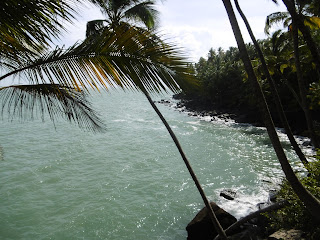After visiting the ruins, our pleasant walk around the island was quite a startling contrast to the heavy silence of the decaying prison cells and hallways. (Click on photos to enlarge.)
There were a few cliffs on Saint Joseph Island as well as large slabs of stone along the path.
In the background, there's the infamous Devil's Island to the right and Royal Island to the left where our hotel is located.
There's also a large cemetery on Saint Joseph which was used exclusively for the prison wardens and their families...
It seemed very peculiar to see all of these graves so close to the ocean.
Unlike the prison guards, convicts were buried out at sea. Their bodies were simply dropped overboard to be eaten by sharks as the pictures below shows. This practice is what made the waters around the Salvation Islands so shark infested... successfully discouraging the convicts from ever trying to escape by swimming off the islands.
The only beach (actually more pulverized shells than sand) on the Salvations Islands is here too. However, at low tide (like on the picture) you have to walk over large black stones to reach the water to swim. Most people prefer to wait for high tide.
Here's a bread fruit tree that grows all over French Guiana. The fruit is edible and can really feed a lot of people. One easy recipe is to just pluck it off the tree when it's big and ripe and wrap it in aluminum foil. Then, place it on the coals of a barbecue for an hour or two. When you eat it, you can smear it with butter or dunk it in sauce or dips-- it's quite nice!
vendredi 30 décembre 2016
samedi 10 décembre 2016
Saint Joseph Island -- Part One
During the school holidays at the end of October, Jack and I were able to set foot on Saint Joseph Island for the first time since our arrival in French Guiana. It is the second largest of the Salvation Islands after Royal Island but is uninhabited today except for a small army team responsible for maintenance. (Click on pictures to enlarge.)
Saint Joseph Island is a real Caribbean gem, but it is very small. In fact, it only took us an hour to go around the entire island.
Here's a picture with Royal Island on the left (where our hotel is located) and the infamous Devil's Island on the right.
During the penal colony period, Saint Joseph was much closer to hell than the island paradise it is today. The convicts had to build all the buildings and roads on Saint Joseph and this one leads to the ruins of the prison cells.
Contrary to Royal Island, Saint Joseph was used for isolated confinement as a means to punish the toughest and most dangerous prisoners... but Napoleon III also used it to exile his political enemies.
Here's one of the confinement cells, today full of wild vegetation. At the time of the penal colony, these cells were kept in darkness by thick walls and roof. There was also no furniture or bed and only two pans-- one for food and the other for going to the bathroom. Silence was imposed and if the prisoners attempted to talk to the guards or other prisoners, their isolation confinement got prolonged.
Malnutrition and disease usually killed the convicts before their time in confinement expired.
It's hard to imagine the French prison wardens once pacing up and down this corridor. Today the jungle has reclaimed its right to stand guard over this morbid place of memory.
Saint Joseph Island is a real Caribbean gem, but it is very small. In fact, it only took us an hour to go around the entire island.
Here's a picture with Royal Island on the left (where our hotel is located) and the infamous Devil's Island on the right.
During the penal colony period, Saint Joseph was much closer to hell than the island paradise it is today. The convicts had to build all the buildings and roads on Saint Joseph and this one leads to the ruins of the prison cells.
Contrary to Royal Island, Saint Joseph was used for isolated confinement as a means to punish the toughest and most dangerous prisoners... but Napoleon III also used it to exile his political enemies.
Here's one of the confinement cells, today full of wild vegetation. At the time of the penal colony, these cells were kept in darkness by thick walls and roof. There was also no furniture or bed and only two pans-- one for food and the other for going to the bathroom. Silence was imposed and if the prisoners attempted to talk to the guards or other prisoners, their isolation confinement got prolonged.
Malnutrition and disease usually killed the convicts before their time in confinement expired.
It's hard to imagine the French prison wardens once pacing up and down this corridor. Today the jungle has reclaimed its right to stand guard over this morbid place of memory.
Inscription à :
Commentaires (Atom)

















